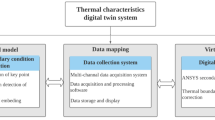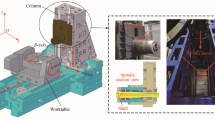Abstract
The thermal error in the spindle unit is substantial and necessitates mitigation. Current models, being predominantly static in nature, have limited efficacy in error control. Integrating digital twin technology for modeling and controlling spindle unit thermal error holds promise in enhancing the machining accuracy of machine tools. Yet, the notion of a digital twin system specifically tailored for spindle unit thermal characteristics remains uncharted territory. To navigate these challenges, this study introduces a novel digital twin system tailored for spindle unit thermal characteristics. This system is poised to revolutionize thermal error modeling and compensation by harnessing the capabilities of digital twin technology. Within this digital twin framework, both the thermal error control model and the analytical thermal characteristic model are seamlessly integrated. The control model is devised as an exponential function, utilizing operational time, inherent time constants, and both initial and equilibrium thermal errors as parameters. Delving deeper, the analytical thermal characteristic model for the spindle system is rooted in a thermal resistance network approach. This leads to a closed-loop thermal characteristic modeling process, culminating in the derivation of a steady-state thermal error. Intricate heat transfer dynamics between spindle components are dissected, and a comprehensive thermal equilibrium equation set is formulated for the spindle unit. This equation set comprehensively accounts for dynamic variations in key parameters such as preload, lubricant viscosity, thermal load intensity, thermal contact resistance, and convective coefficients. To ascertain the time constant, a meticulously designed set of thermal characteristic experiments is executed. Subsequently, the digital twin system embarks on predictive modeling of thermal errors across varied operational conditions. This prediction then forms the foundation for thermal error compensation. With the integration of the present model into the digital twin system, the results are impressive: the absolute average and maximum deviations in thermal elongation, post-error control, stand at approximately 0.40 μm and 1.24 μm, respectively.



























Similar content being viewed by others
References
Cao H, Zhang X, Chen X (2017) The concept and progress of intelligent spindles: a review. Int J Mach Tool Manu 112(1):21–52. https://doi.org/10.1016/j.ijmachtools.2016.10.005
Mayr J, Jedrzejewski J, Uhlmann E, Donmez MA, Knapp W, Härtig F, Moriwaki T, Shore P, Schmitt R, Brecher C, Würz T, Wegener K (2012) Thermal issues in machine tools. CIRP Ann-Manuf Techn 61(2):771–791. https://doi.org/10.1016/j.cirp.2012.05.008
Li H, Shin YC (2004) Integrated dynamic thermo-mechanical modeling of high speed spindles, part 1: model development. J Manuf Sci E-T ASME 126(1):148–158. https://doi.org/10.1115/1.1644545
Chien CH, Jang JY (2008) 3-D numerical and experimental analysis of a built-in motorized high-speed spindle with helical water cooling channel. Appl Therm Eng 28(17):2327–2336. https://doi.org/10.1016/j.applthermaleng.2008.01.015
Liu J, Ma C, Wang S, Wang S, Yang B, Shi H (2018) Thermal-structure interaction characteristics of a high-speed spindle-bearing system. Int J Mach Tool Manu 137:42–57. https://doi.org/10.1016/j.ijmachtools.2018.10.004
Ma C, Yang J, Zhao L, Mei X, Shi H (2015) Simulation and experimental study on the thermally induced deformations of high-speed spindle system. Appl Therm Eng 86:251–268. https://doi.org/10.1016/j.applthermaleng.2015.04.064
Ma C, Mei X, Yang J, Zhao L, Shi H (2015) Thermal characteristics analysis and experimental study on the high-speed spindle system. Int J Adv Manuf Tech 79(1):469–489. https://doi.org/10.1007/s00170-015-6821-z
Ma C, Zhao L, Shi H, Mei X, Yang J (2017) Experimental and simulation study on the thermal characteristics of the high-speed spindle system. P I Mech Eng C-J Mec 231(6):1072–1093. https://doi.org/10.1177/0954406216631573
Pouly F, Changenet C, Ville F, Velex P, Damiens B (2010) Power loss predictions in high-speed rolling element bearings using thermal networks. Tribol T 53(6):957–967. https://doi.org/10.1080/10402004.2010.512117
Pouly F, Changenet C, Ville F, Velex P, Damiens B (2010) Investigations on the power losses and thermal behaviour of rolling element bearings. P I Mech Eng J-J Eng 224(9):925–933. https://doi.org/10.1243/13506501JET695
Takabi J, Khonsari MM (2013) Experimental testing and thermal analysis of ball bearings. Tribol Int 60:93–103. https://doi.org/10.1016/j.triboint.2012.10.009
Shi H, He B, Yue Y, Min C, Mei X (2019) Cooling effect and temperature control of oil cooling system for ball screw feed drive system of precision machine tool. Appl Therm Eng 161(10):114150. https://doi.org/10.1016/j.applthermaleng.2019.114150
Liu T, Gao W, Zhang D, Zhang Y, Chang W, Liang C, Tian Y (2016) Analytical modeling for thermal errors of motorized spindle unit. Int J Mach Tool Manu 112:53–70. https://doi.org/10.1016/j.ijmachtools.2016.09.008
Ramesh R, Mannan MA, Poo AN, Keerthi SS (2003) Thermal error measurement and modelling in machine tools. Part II. Hybrid Bayesian Network-support vector machine model. Int J Mach Tool Manu 43(4):405–419. https://doi.org/10.1016/S0890-6955(02)00264-X
Wang L, Wang H, Li T, Feng Li (2015) A hybrid thermal error modeling method of heavy machine tools in z-axis. J Adv Manuf Tech 80:389–400. https://doi.org/10.1007/s00170-015-6988-3
Liu K, Sun M, Zhu T, Wu Y, Liu Y (2016) Modeling and compensation for spindle’s radial thermal drift error on a vertical machining center. Int J Mach Tool Manu 105:58–67. https://doi.org/10.1016/j.ijmachtools.2016.03.006
Mayr J, Müller M, Weikert S (2016) Automated thermal main spindle & B-axis error compensation of 5-axis machine tools [J]. CIRP Ann-Manuf Techn 65(1):479–482. https://doi.org/10.1016/j.cirp.2016.04.018
Ramesh R, Mannan MA, Poo AN (2003) Thermal error measurement and modelling in machine tools: part I. Influence of varying operating conditions. Int J Mach Tool Manu 43(4):391–404. https://doi.org/10.1016/S0890-6955(02)00263-8
Liu H, Miao E, Wei X, Zhuang X (2016) Robust modeling method for thermal error of CNC machine tools based on ridge regression algorithm. Int J Mach Tool Manu 113:35–48. https://doi.org/10.1016/j.ijmachtools.2016.11.001
Abdulshahed AM, Longstaff AP, Fletcher S (2015) The application of ANFIS prediction models for thermal error compensation on CNC machine tools. Appl Soft Comput 27(7):158–168. https://doi.org/10.1016/S0890-6955(02)00263-8
Ma C, Zhao L, Mei X, Shi H, Yang J (2017) Thermal error compensation of high-speed spindle system based on a modified BP neural network. J Adv Manuf Tech 89(3071–3085):1–15. https://doi.org/10.1007/s00170-016-9254-4
Ma C, Zhao L, Mei X, Shi H, Yang J (2017) Thermal error compensation based on genetic algorithm and artificial neural network of the shaft in the high-speed spindle system. P I Mech Eng B-J Eng. 231(5):753–767. https://doi.org/10.1177/0954405416639893
Tan B, Mao X, Liu H, Li B, He S, Peng F, Yin L (2014) A thermal error model for large machine tools that considers environmental thermal hysteresis effects. Int J Mach Tool Manu 82–83(7):11–20. https://doi.org/10.1016/j.ijmachtools.2014.03.002
Feng W, Li Z, Gu Q, Yang J (2015) Thermally induced positioning error modelling and compensation based on thermal characteristic analysis. Int J Mach Tool Manu 93(6):26–36. https://doi.org/10.1016/j.ijmachtools.2015.03.006
Yang H, Ni J (2005) Dynamic neural network modeling for nonlinear, nonstationary machine tool thermally induced error. Int J Mach Tool Manu 45(4–5):455–465. https://doi.org/10.1016/j.ijmachtools.2004.09.004
Liu J, Ma C, Gui H, Wang S (2021) Thermally-induced error compensation of spindle system based on long short term memory neural networks. Appl Soft Comput 102:107094. https://doi.org/10.1016/j.asoc.2021.107094
Liu J, Gui H, Ma C (2023) Digital twin system of thermal error control for a large-size gear profile grinder enabled by gated recurrent unit. J Amb Intel Hum Comp 14:1269–1295. https://doi.org/10.1007/s12652-021-03378-4
Wang J, Niu X, Gao RX, Huang Z, Xue R (2023) Digital twin-driven virtual commissioning of machine tool. Robot Cim-Int Manuf 81:102499. https://doi.org/10.1016/j.rcim.2022.102499
Liu J, Wen X, Zhou H, Sheng S, Zhao P (2022) Digital twin-enabled machining process modeling. Adv Eng Inform 54:101737. https://doi.org/10.1016/j.aei.2022.101737
Liu S, Bao J, Zheng P (2023) A review of digital twin-driven machining: from digitization to intellectualization. J Manuf Syst 67:361–378. https://doi.org/10.1016/j.jmsy.2023.02.010
Tao F, Xiao B, Qi Q, Cheng J, Ji P (2022) Digital twin modeling. J. Manuf Syst 64:372–389. https://doi.org/10.1016/j.jmsy.2022.06.015
Wei Y, Hu T, Dong L, Ma S (2023) Digital twin-driven manufacturing equipment development. Robot Cim-Int Manuf 83:102557. https://doi.org/10.1016/j.rcim.2023.102557
Creighton E, Honegger A, Tulsian A, Mukhopadhyay D (2010) Analysis of thermal errors in a high-speed micro-milling spindle. Int J Mach Tool Manu 50(4):386–393. https://doi.org/10.1016/j.ijmachtools.2009.11.002
Kim KD, Kim MS, Chung SC (2004) Real-time compensatory control of thermal errors for high-speed machine tools. P I Mech Eng B-J Eng 218(8):913–924. https://doi.org/10.1243/095440504148616
ISO 230–3 (2007) Test code for machine tools part 3: determination of thermal effects, ISO copyright office, Switzerland. https://www.iso.org/standard/39188.html
Zhu J, Ni J, Shih AJ (2008) Robust machine tool thermal error modeling through thermal mode concept. J Manuf Sci E-T ASME 130(6):763–771. https://doi.org/10.1115/1.2976148
Zimmermann N, Müller E, Lang S, Mayr J, Wegener K (2023) Thermally compensated 5-axis machine tools evaluated with impeller machining tests. CIRP J Manuf Sci Tec 46:19–35. https://doi.org/10.1016/j.cirpj.2023.07.005
Zhao H, Yang J, Shen J (2007) Thermal error optimization modeling and real-time compensation on a CNC turning center. Int J Mach Tool Manu 207:172–179. https://doi.org/10.1016/j.jmatprotec.2007.12.067
Funding
This research was supported by the National Natural Science Foundation of China (Grant numbers 52275474 and 51905057), the China Postdoctoral Science Foundation (2022M720565), the Natural Science Foundation Project of Chongqing, Chongqing Science and Technology Commission, China (Grant number cstc2019jcyj-msxmX0050), the Fundamental Research Funds for the Central Universities, China (Grant number 2020CDJQY-A036), the Venture & Innovation Support Program for Chongqing Overseas Returnees (Grant number cx2019054), and State Key Laboratory for Manufacturing Systems Engineering, China (Grant number sklms2020016).
Author information
Authors and Affiliations
Contributions
All authors contributed to the study conception and design. Material preparation, data collection, and analysis were performed by Jialan Liu, Chi Ma, and Qiang Yuan. The first draft of the manuscript was written by Jialan Liu, and all authors commented on previous versions of the manuscript. All authors read and approved the final manuscript.
Corresponding author
Ethics declarations
Competing interests
The authors declare no competing interests.
Additional information
Publisher's Note
Springer Nature remains neutral with regard to jurisdictional claims in published maps and institutional affiliations.
Rights and permissions
Springer Nature or its licensor (e.g. a society or other partner) holds exclusive rights to this article under a publishing agreement with the author(s) or other rightsholder(s); author self-archiving of the accepted manuscript version of this article is solely governed by the terms of such publishing agreement and applicable law.
About this article
Cite this article
Liu, J., Ma, C. & Yuan, Q. Spindle unit thermal error modeling and compensation based on digital twin. Int J Adv Manuf Technol 132, 1525–1555 (2024). https://doi.org/10.1007/s00170-024-13445-7
Received:
Accepted:
Published:
Issue Date:
DOI: https://doi.org/10.1007/s00170-024-13445-7




